11 Best Platforms To Sell Ebooks In 2024 (Comparison)
Looking for the best platforms to sell ebooks? We’ve got you covered!
Selling ebooks online can be very lucrative. And these days, you don’t need to be picked up by a major publisher to make sales. it’s easier than ever to self-publish and sell directly to consumers through online platforms.
In this post, we’ll be looking at the best platforms to sell ebooks through. We’ve included a mixture of ecommerce platforms, online marketplaces, and distribution services to cover all bases.
The best platforms to sell ebooks – summary
TL;DR:
- Sellfy – The best platform to sell ebooks online. You can also use it to sell other digital products, subscriptions, physical products, and print-on-demand merchandise.
- Podia – This is a great option for authors that also want to sell courses alongside their ebooks. It’s not suitable for selling physical products, but you can create paid/free communities, and more. Includes email marketing and customer messaging. Free plan available.
- PublishDrive – Book distribution service that can be used for ebooks, audiobooks, and print books.
#1 – Sellfy
Sellfy is our top pick for the best ecommerce platform to sell ebooks. Create your own online store or sell via your own website. It’s built specifically for creators, so it’s super easy to use, and a great choice for authors who aren’t too tech-savvy and want a hassle-free way to self-publish and start selling.
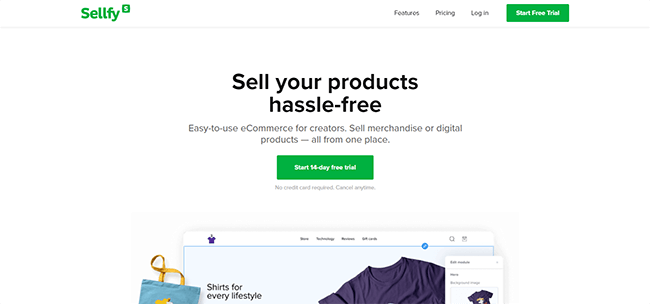
You can use Sellfy to sell all kinds of products. Aside from ebooks, you can also sell other digital products like video and audio, which is great if you plan on turning your ebook into an audiobook in the future.
You can even sell physical products and print-on-demand merchandise. If your ebook sells really well, you could create your own branded line of printed tees and mugs themed around your book for avid readers to purchase.
Because Sellfy is built for creators, rather than big businesses, it’s designed to be as simple as possible to use. You can set up your store in a few clicks. Then, customize the look and feel of it, upload your ebook, set your pricing, and start selling.
You can add upsells to your checkout to increase order values, and create discount codes to drive purchases.
And you can sell off the platform too. You can add ‘buy now’ buttons and embeddable product cards that connect to Sellfy’s checkout on any website. Plus, use product links to sell through social media, or use video end screens and cards to sell through YouTube.
If you plan on running paid ad campaigns to promote your book, you can add Facebook and Twitter tracking pixels to track your performance. And did I mention that Sellfy has no transaction fees or hidden costs?
Pricing
Paid plans start at $19/month.
#2 – Podia
Podia is an all-in-one ecommerce platform that you can use to build your own online store and sell ebooks, plus other digital products like courses, memberships, digital downloads, etc.

When it comes to selling ebooks online, you have two choices: You can sell through a third-party marketplace like Amazon or you can sell through your own online store. Podia helps with the latter. And as a result, you keep more of the profit.
Templates and an intuitive website builder make it quick and easy to create your online storefront, with no code or design skills necessary, and customize it to fit your brand. You have control over the look and feel of your website and can change the color schemes, logos, buttons, pages, sections, etc.
From there, you can upload your ebooks (or any other digital product you want to sell) to your product catalog and spin up a sales page for it. Podia manages your checkout for you, and customers can log in to access the products and courses they’ve purchased.
With Podia’s Community feature, you could even build a community around your ebook where readers can share their thoughts, kind of like a virtual book club.
And if you want, you can bundle your ebook together with paid community plans to increase order values.
Aside from digital downloads and communities, you can also build and sell online courses with Podia. There’s even an integrated course builder that you can use to create your curriculum. If you already sell an educational ebook, expanding out into other knowledge products like courses could be a great way to scale up.
But the best thing about selling through Podia is that as long as you sign up for a paid plan, you won’t have to pay any additional transaction fees and can keep 100% of your revenue—something you don’t get if you choose to sell through third-party marketplaces instead.
Of course, the flip side is that you’ll have to build an audience from scratch and drive all your own traffic and sales. Fortunately, Podia comes with a ton of marketing tools to help with this, including email and affiliate marketing.
Pricing
Podia offers a free plan but it comes with 8% transaction fees and only lets you sell one product.
Paid plans with zero transaction fees, higher usage caps, and other benefits start from $33/month. You can also try it out with a 14-day free trial.
#3 – PublishDrive
PublishDrive is a one-stop ebook distribution platform that distributes your ebook to all major online channels, including Amazon, Scribd, Apple Books, Google Books, and over 240k+ digital libraries.
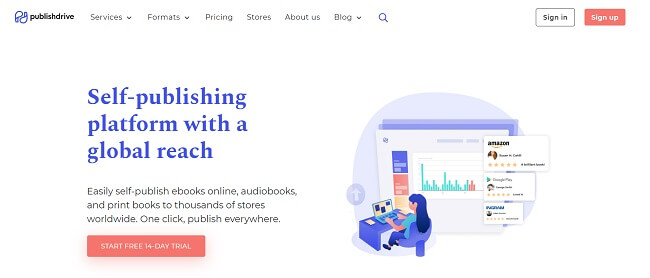
PublishDrive is different from the other platforms on this list in that it’s not somewhere you can list your ebooks for sale. It’s solely a self-publishing platform that authors can use to distribute their books across the internet and tap into a global market of over 2.5 billion potential readers.
When you use PublishDrive, you don’t have to upload your ebooks to each online marketplace or library separately—you just upload it once and it’s everywhere, instantly. This is a real game-changer that can save you hours of time.
Not only that, but because PublishDrive distributes your ebook globally, it also gives you access to hard-to-reach markets in places like China.
And it couldn’t be easier to use PublishDrive. Just sign up, upload your manuscript and cover files, use PublishDrive to format it and put it all together, and publish.
From there, you can start promoting your book using PublishDrive’s built-in suite of marketing tools. And track your sales performance, ratings, rankings, and royalties in real-time from your analytics dashboard.
If you ever decide to have your ebook printed, PublishDrive can also help you distribute physical books to over 39,000 global book stores, as well as audiobooks.
Pricing
Plans start at $16.99/month or $169.99/year. PublishDrive only charges a flat monthly or annual subscription rate so you’ll never pay transaction fees and can keep 100% of your royalties.
You can get started with a 14-day free trial.
#5 – Payhip
Payhip is another ecommerce solution that’s perfect for selling ebooks. It stands out for its simplicity, with a beginner-friendly interface that makes it easy to create a professional online store in minutes.
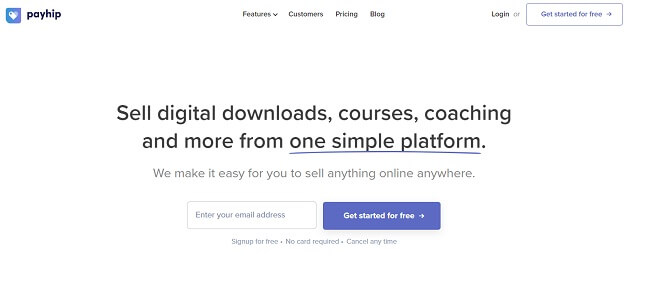
There’s not a lot we can say about Payhip that we haven’t already said about other stores. It comes with all the usual features: a store builder, payments system, marketing tools, etc.
But what makes Payhip great is its interface. It’s clean, simple, and easy to use, which makes it a good choice for beginners who don’t have a lot of web design experience.
As with most platforms, you can sell all kinds of digital products, including ebooks, software, video, coaching, memberships, courses, plus physical products.
There are a couple of advanced sales features including a nifty ‘pay-what-you-want’ pricing option and a powerful coupon engine. The platform uses PayPal and Stripe to take payments, and depending on what plan you sign up for, there may be transaction fees.
Pricing:
Payhip offers a free forever plan that includes all features and unlimited products & revenue. A transaction fee of 5% applies to free users.
The Plus plan costs $29/month plus a 2% transaction fee, or you can opt for the $99/month Pro plan with no transaction fees.
Read our Payhip review.
#5 – SendOwl
SendOwl is an all-in-one checkout solution that helps you to sell ebooks and other digital files to your customers. It enables you to take payments and automatically delivers the ebook file to buyers.

SendOwl isn’t an ecommerce platform like Podia or Sellfy, so you can’t use it to build your website. It only provides the checkout—not the product pages. Therefore, you’ll need your own website or somewhere else to sell from.
For example, if you have a Shopify store, you can connect it to SendOwl. Shopify powers the backend of your ecommerce store and SendOwl provides the capability to sell digital products.
Alternatively, you can use buy buttons to point customers to your SendOwl checkout from your social media account, emails, WordPress website, etc.
Aside from the streamlined checkout, SendOwl also comes with a bunch of other features to help you manage product delivery.
You can use the Drip feature to deliver ebook content to your customers chapter-by-chapter. This allows you to sell your ebooks through a recurring subscription model rather than through one-off payments, which can increase revenues.
You can also set up license keys when you upload your ebook to help prevent fraud and make sure readers don’t duplicate your content.
And let’s not forget the built-in marketing tools. You can promote your ebook and drive sales with the built-in affiliate marketing system, automated cart abandonment emails, 1-click upsells, and more.
Pricing:
Paid plans start at $19/month with no additional transaction fees. Just bear in mind that there are usage caps on the paid plan and overages apply if you exceed your order or storage limits.
You can get started with a 30-day free trial.
Read our SendOwl review.
#6 – Shopify
Shopify is one of the most popular ecommerce platforms in the world. Millions of merchants use it to sell all kinds of physical and digital products online, including ebooks.
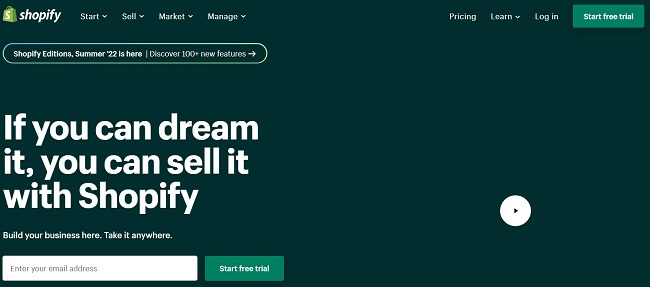
You can use Shopify to create and customize an online store, then use it to sell ebooks or any other type of product. It’s a fully-hosted platform that comes with all the tools you need to run your business, including a drag-and-drop website builder, product management tools, checkouts & payments, shipping tools, marketing tools, and more.
If you already have an existing website, you can also use Shopify buy buttons to add ecommerce to it.
Shopify offers a good mix of simplicity and extensibility. It’s easier to set up your ecommerce store on Shopify compared to alternatives like WordPress & WooCommerce, but it still offers a good level of control and flexibility. In the Shopify App store, you can find hundreds of third-party apps that you can install to extend the functionality of your store.
The biggest downside is that you have to use Shopify Payments (Shopify’s payment gateway) to avoid transaction fees. If you use a third-party payment provider like Stripe or PayPal, you’ll be charged additional fees of 0.5% to 2% depending on your plan.
Pricing:
Plans start at $5/month. Annual discounts are available.
Get started with a 3-day free trial, then $1/month after for 3 months.
#7 – Lemon Squeezy
Lemon Squeezy is a lesser-known ecommerce platform that’s definitely worth checking out. As its name suggests, it’s designed to make it ‘easy peasy’ to sell digital products like ebooks online.
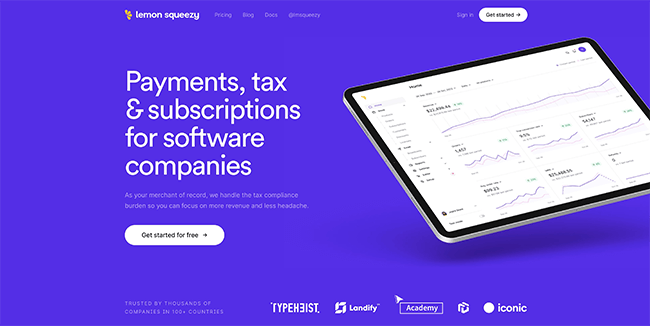
Lemon Squeezy is another platform that makes it very simple to get started, so it’s great for solopreneurs who want to avoid the usual headaches involved in building a store.
You build your store on the front in an intuitive editor; no coding is required and all pages are mobile-optimized.
There are lots of native marketing tools, including bundles & upsells, email marketing software, a discount engine, lead magnets, and more.
The built-in email marketing solution, in particular, deserves a lot of praise. You get access to a beautifully simple email editor and can send targeted broadcasts, automated campaigns, etc.
Advanced features like personalization, in-depth reporting (track open rates, click rates, etc.), and a high deliverability rate make it one of the best email marketing tools of any platform on this list.
We also like Lemon Squeezy’s tax compliance features. It handles all sales tax and EU VAT for you to make it easier to navigate international tax law.
Pricing:
It’s free to sign up for Lemon Squeezy. There are no subscription fees, but the platform takes a cut of each of your sales. Fees are 5% +50¢ per transaction.
#8 – Apple Books
Apple Books is a mobile ebook reading and store app. If you want to tap into the mobile reading market, it’s a great place to sell your ebooks.
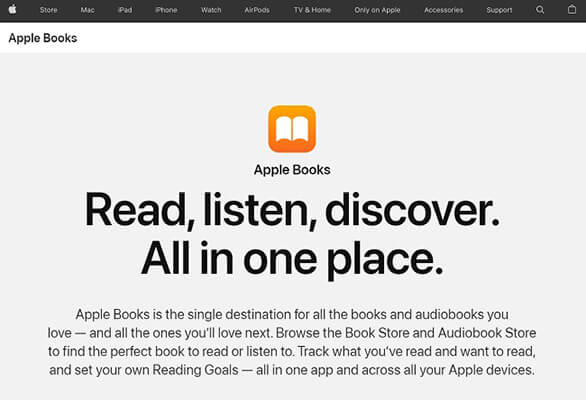
When you list your ebooks on Apple Books, they’re discoverable in the Apple Book Store. This gives you access to a huge market of potential customers. Millions of Apple users browse the app for reading inspiration on their iPhone or iPad every month and any of them could stumble on your ebook and decide to buy it.
The downside is that Apple Books takes a big cut of your sales. You receive 70% of the listing price as royalties and the rest goes to them. But there are no other hidden fees and no third-party ads.
The publishing process on Apple Books is straightforward. You’ll need to log into your iTunes account and then upload it in EPUB file format.
Pricing:
You can sell your ebooks on Apple Books for free, with no listing fees. However, Apple takes a 30% cut of your sales revenue so you earn 70% royalties per sale.
#9 – Google Play
Google Play is Google’s answer to Apple Books. It’s another mobile reading app where you can list your ebooks for sale.

Listing your ebooks on the Google Play store opens up the huge Android market. There are more Android users than any other mobile OS, including Apple iOS, so selling on Google Play is essential if you want to expand your reach as far as possible.
You don’t have to grant Google exclusive rights to sell on Play, so you can list it on other marketplaces too. Once you sign up and upload your ebook, you can choose which countries to sell in and set your own listing prices. Google handles everything else for you.
Pricing:
There are no listing fees for selling ebooks on Google Play but the platform will take a cut of your revenue on every sale. The amount will depend on the sale price.
#10 – BigCommerce
BigCommerce is another very popular ecommerce solution that’s used by thousands of retailers. You can use it to sell ebooks as well as any other type of digital product.

It’s also our top-rated Shopify alternative.
Like many of the other platforms we’ve looked at, BigCommerce comes with a visual editor that you can use to create and customize your storefront, as well as various marketing, payment, and store management features.
It’s very much an all-in-one solution that aims to give you everything you need to run your online business in one place.
Pricing
Plans start from $39 per month with no transaction fees. You can try it out for free for 15 days. Save 25% with a yearly subscription.
#11 – Amazon
Amazon is the largest online retailer in the world. Over half of all ecommerce sales in the US happen on Amazon—and over two-thirds of all ebook sales—so it’s a fantastic place to sell.
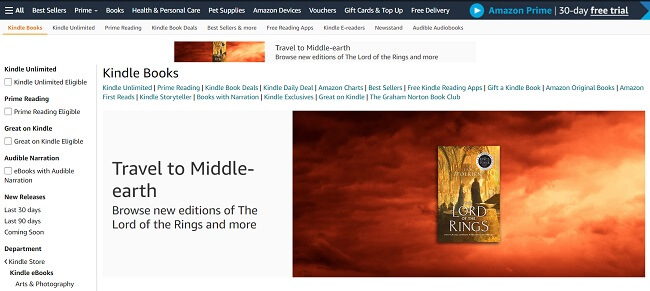
To get started, you can sign up for Amazon’s Kindle Direct Publishing (KDP), then publish your ebook to your Bookshelf. You can upload it in Kindle format, or in a PDF or Word file if you want to let Amazon convert it for you.
The whole process takes less than 10 minutes and once you’re done, you’ll be able to reach an enormous number of potential readers.
Pricing:
It’s free to sign up and publish your ebooks on KDP but Amazon takes a cut of your sales revenue. You’ll earn between 35% and 70% royalties, depending on your book price.
Wrapping it up
As you can see, you have plenty of options when it comes to selling ebooks—but you don’t have to just stick with one platform.
On the contrary, it’s best to list your ebooks for sale as far and wide as possible. This will enable you to reach more potential customers and maximize your sales opportunities. With that in mind, here’s what we’d suggest:
- Use Sellfy to build your own online storefront and sell ebooks through your own website. You can also sell complementary products such as subscriptions and other digital products. Sellfy also allows you to sell physical products and print-on-demand products.
- Podia is the best option for authors that want to sell a variety of digital products including courses. It’s not suitable for physical products, however. It includes some useful additional features such as email marketing and affiliate marketing. There’s also a free plan.
- Use PublishDrive to distribute your ebook to online marketplaces like Amazon, Apple Books, and Google Play. It’ll save you a ton of time as you won’t have to publish it to each platform separately, and instantly give you access to billions of potential readers across the world.
Not sure which platform to choose? The good news is that most platforms either offer limited free plans or free trials so you can test to find the platform that fits your needs.
If you want to explore more content about selling online, be sure to check out these posts:
Disclosure: If you buy through links on our site, we may make a commission. This helps to support the running of Startup Bonsai.
